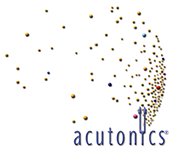Ellen Franklin, PhD & Donna Carey, LAc
Oriental Medicine Journal, Late Summer/Earth 2008
Earth: Our Home Planet
Character of the Planet: Sustenance, nurturance,wholeness
Tuning Fork Properties:
Ohm (Fundamental Home Tone): The Earth traveling around the Sun through the seasons in its 365-day yearly orbit.
Color: Gold
Approximate Musical Note: C#
Interval with Ohm: Ohm Unison, Ohm Octave
Intervallic Personality: Grounding and balancing
Earth Day: The Earth rotating on its own axis in a 24-hour cycle.
Color: Green
Approximate Musical Note: G
Interval with Ohm: Earth Day 5th, Generative, Tonifying
Intervallic Personality: Stimulating and strengthening
Zodiac Earth: The Earth cycling through all signs of the Zodiac in a 25,920-year procession.
Color: Purple
Approximate Musical Note: F
Interval with Ohm: Zodiac 3rd, relaxing, meditative, sedating, transcendental
Intervallic Personality: Wisdom and experience
Types of Earth Imbalances: Lack of grounding, overall feeling of imbalance, imbalances of the liver, disharmonies of the sacrum and hips, disharmonies of the legs and feet, low energy, lack of immune function, general deficiency, stagnation, constriction, stress, tension.
Healing Themes & Archetypal Keywords: Grounding, nature, connectedness, sustenance, matter, physicality, mother, food, emotional homework, creativity, challenges of being in physical form, the earth body energy as a whole, and the whole life cycle; birth, life, death, wisdom, and experience.
Anatomical and Physiological Correspondences: Body energy as a whole, balance in the body systems.
Energetics: Earth represents the ability to be comfortable in the body, and the homework each of us must do. It provides the balance and sustenance needed to complete life’s destiny successfully.
Acutonics is an integrated system of healing and education that incorporates ancient Taoist teachings of the meridians, pre-meridians, and the immortal body with sound. It also draws on depth psychology, ancient wisdom traditions, and contemporary science. This system was co-developed by Donna Carey, LAc, and has evolved through the combined efforts of Donna, Ellen Franklin and more than fifty Acutonics instructors, who teach this work around the globe. Acutonics has been integrated into many western medical environments with client populations that are critically ill, young children, and the needle phobic. It is a modality that makes the basic principals of East Asian Medicine and energetic healing accessible in a non-invasive way and provides an adjunct therapy that can be easily integrated into the practice of East Asian Medicine. The powerful sounds of the Universe are brought into the world of healing through the use of precision calibrated planetary tuning forks and symphonic planetary gongs.
The study of planets, planetary correspondences, and planetary influences has affected our emotional and psycho-spiritual make-up throughout history, dating back more than 6,000 years to ancient Sumer. Planetary study was also evident in Mesopotamia, Chaldea, Greece, Rome, Egypt, the Islamic World, the Indus Valley and China, and although somewhat controversial was apparent during the Christian Middle ages, resurfacing during the Renaissance. Through the planets we gain a deep understanding of rich archetypal maps and powerful myths that provide a window into the collective psyche. They also provide us with a symbolic language that reflects how humanity defined its unique position in the universe during the earliest cycles of history. There was no separation. The universe without was the universe within as above so below. Our ancestors knew by instinct that what happened in the skies above was related to life on Earth, and that if we understood the heavens, we could gain a deeper understanding of ourselves. In contemporary times many people have lost sight of the recognition that the planets, stars, sun, and moon, don’t just impact the Earth, but they impact each one of us, and what happens to our Earth can’t help but be reflected in us.
The Music of the Spheres or the Heavenly Harmonies, the sound of the planets as they travel around the sun, provides a musical link to the archetypal richness of the planets and reconnects to this rich legacy of correspondence. This link, which is represented in number and tone, provides a resonance that reaches deep within us. Pythagoras, who understood that sound was the generator of the universe, provides us with a deep understanding of the laws of creation. This is also reflected in Plato’s Timaeus,
The motions in us that are akin to the divine are the thoughts and revolutions of the universe. We should each therefore attend to these motions and by learning about the harmonious circuits of the universe repair the damage done at birth to the circuits in our head, and so restore understanding and what is understood to their original likeness to each other. When that is done we shall have achieved the goal set us by the gods.[1]
Pythagoras believed that all is number, and he created a systematic study of mathematics and harmony “which united, as one transcendent science epitomized in music, the laws at once of outer space (cosmology), inner space (psychology) and the arts (aesthetics)—the two apparently contrary approaches of the visionary and the empiricist were brought and held together as substantially in accord.”[2] But this idea of sound as a generator of the universe, Campbell points out, is fundamental to the Vedas, the Hindus, and the Chinese. Quoting from Tung Chung-Shu, a later Confucian scholar, writing in the second century B.C.
Tuned to the tone of Heaven and Earth, the vital spirits of man express all the tremors of Heaven and Earth, exactly as several citharas, all tuned on Kung (the tonic) all vibrate when the note Kung resounds. The fact of the harmony between Heaven and Earth and Man does not come from physical union, from a direct action, it comes from a tuning of the same note producing vibrations in unison...In the Universe there is not hazard, there is no spontaneity; all is influence and harmony, accord answering accord.[2]
In both the Western tradition and in the ancient texts from China we see the relationship between mind and body, that the body is a microcosm, in a dynamic relationship with the natural world. Sivin citing the Inner Cannon of the Yellow Emperor writes,
The body was defined not by what sets it apart but by its intimate, dynamic relationship with its environment. “Covered over by heaven, borne up by Earth, among the myriad things none is more noble than man. Man is given life by the ch’i of heaven and earth, and grows to maturity following the norms of the four seasons”...Life is maintained not merely by the internal circulation of ch’i, but by continuous dynamic interchange between body and cosmos. Shared vital rhythms make the body correspond to heaven and earth, and them in accord. [3]
These are just a few examples of how the planets, the heavenly harmonies, and Earth, so often defined in mythological and archetypal terms, also relate to the practice of East Asian Medicine. These rich, textural concepts helped us to make sense of creation itself, and to shape our perception and understanding of human physiology, the psyche, science, and medicine. Acutonics also helps us to cultivate the Tao, our original spirit, and to learn how to access heaven, how to create harmony with the different levels of energy in our Universe, and how to become aware of the vastness and power of the forces that influence us both on the physical and non-physical plains of existence.
The Earth
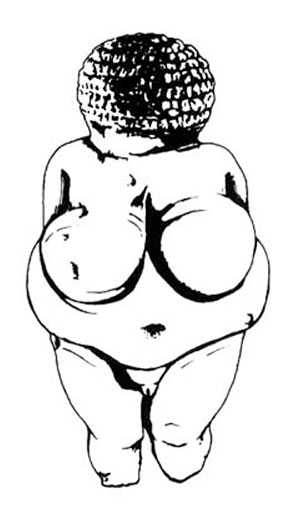 Greek: Ge, Gaia
Greek: Ge, Gaia
Roman: Gaia, Terra, or Tellus
Whether we go back to the early Greek, to the dawn of time or to ancient China, the first myths are the creation myths. Stories of the beginning of time were created to help humanity make sense of their complex pre-scientific existence and to answer the most basic question, where did I come from? “This original question about the origin of the world is at the same time the question about the origin of man, the origin of consciousness and of the ego; it is the fateful question...that faces every human being as soon as they arrive on the threshold of self-consciousness.”[4]
In the beginning there was Chaos and from this emerged the first gods and goddesses of the early Greeks. In the Theogony and Works and Days from the Greek writer Hesiod we learn how the first gods, and all of creation came into existence. The goddess Ge was the first to be born from primeval Chaos, along with Tartarus, Eros, Erebus and dark Night. Night and Erebus produced the upper atmosphere, Aether and Day. The virgin mother, Ge produced Uranus the sky god, the Mountains, and Pontus the sea. From her union with Uranus the twelve Titans were born, which represent various aspects of nature. Significant among them are Oceanus, Hyperion, who came to be associated with the Sun God, and Phoebe identified with the Moon God, and of course Cronus, champion of his mother, and husband to Rhea. Ge and Uranus also gave birth to the one eyed Cyclopes, Brontes (Thunder), Steropes (Lightening) and Arges (Bright), and the hundred armed, multi-headed creatures known as Hecatonchires.[5-8]
Uranus hated the Cyclopses, and many armed giants, and pushed these monstrous offspring, back into Gaia’s womb, causing her excruciating pain. Angry at the abuse of her mate she gave her son Cronus a sickle with which he castrated his father, and cast his genitals into the sea. From the blood of his genitals the furies, giants, and nymphs were created, and from the genitals themselves, out of the ocean’s foam Venus sprang forth. But as the saying goes, like father like son, Cronos turned out to be as brutal as his father before him, eating his children, for fear one of them would overthrow his rule. Gaia helps Rhea to save Zeus, the last child of the Union between Rhea and Cronos.
Demeter, of the Eleusinian Mysteries is also viewed as a great Earth Goddess, associated with fertility. She is also identified with the Roman Earth grain goddess, Ceres, and the Egyptian Isis. Most of the myths about Demeter focus on her distress at the abduction of her daughter Persephone, spirited away to the underworld by Hades. In her exploration of the early evolution of Greek thought, Guthrie sees two distinct paths. One path is the Olympians Gods primarily derived from the writings of Homer, who are powerful heroes, “...gods are simply more powerful persons who might fight for or against one, with whom one makes bargains or contracts.” The second path is the path of the more feminine Eleusinian mysteries, such as those of Demeter, who emerges as the Mother of Life, represented in artwork, worshiped in the eastern Mediterranean, the pre-Indo European culture of Anatolia, and in the nature-worship cultures of Asia. “The Mother-goddess is the embodiment of the fruitful earth, giver of life and fertility to plants, animals and men. Her cult takes certain forms, involving at least the more elementary kinds of mysticism, that is, the belief in the possibility of a union between the worshipper and the object of the worship.”[9]
Bolen, citing mythologist Jane Harrison, demonstrates the significant fragmentation of the Great Mother goddess, as her attributes, symbols, and powers were divided out, “Hera got the ritual of the sacred marriage, Demeter her mysteries, Athena her snakes, Aphrodite her doves, and Artemis her function as the Lady of the Wild Things.”[10] This division of powers may well represent the beginning of the destruction of the Goddess cultures, the invasion of the Indo Europeans, and the rise of Christianity, as the male Olympic deities began to take the place of prominence in Greek thought, and shrines of the Goddess were destroyed.[9, 10]
The worship of a female earth divinity, by whatever name, Ge, Rhea, Hera, Demeter, Isis, however varied her worship, is significant in all periods. Walker states, she is the Universal Parent. Thousands of feminine names have been given to the Earth. The continents, Asia, Africa, and Europe, and nations, including Russia, Scotland and Ireland, were named for the Great Mother. “Mother Earth received universal worship because she was the universal parent. American Indians still relate how all peoples and animals in the beginning emerged from Earth’s yonic hole. Siberian reindeer hunters say the human race emerged from a Goddess, whose carved figurines protect the hunter’s hut, when given offerings and prayers.”[11]
These primal myths, which help the earliest civilizations make sense of their existence, have many similarities common among them. There is creation emerging from the great void, where the parents, earth and sky, come together in a primal union that cannot be broken apart. This is found in the creation myths of Polynesia, as well as the Maori of New Zealand. In their myth Rangi Nui, the Sky, lay upon Papa-tu-a-nuku, the Earth, and they would not separate. Their children, impatient of being held in the darkness, plotted ways to separate their parents so that they could be released into the world of light. There are also significant creation myths that reflect emergence from the primal sea or waters, such as the goddess mother Nammu of the Sumerians who emerges from the sea to give birth to Heaven and Earth. Both of these creation myths have some resemblance to that of Uranus and Ge.[2]
Although some creation myths provide us with extreme polarization where the opposition between good and evil is very strong, more often we find that the image of two creator gods is used to delineate between male and female, light and dark, gracefulness and clumsiness.[12] There are also many creation myths, where there is no gender assigned to the creation of the Universe, or where the great creator god is male. However, today Earth is most commonly referred to as female, representing the Mother, and contained within this mythic and archetypal vision are both aspects of humanity, male and female, yin and yang.
 Another symbol of creation, found throughout the early myths from Egypt, India, Africa, China, and New Zealand, is the world egg, the round. These creation stories begin with the cosmic egg. This circle without beginning or end, a symbol of the parents of the world, portrayed in equal stature, as they lie on top of each other representing the original unity.[13] In a Brahmanas Creation myth the golden egg emerges from the primal sea. In an Orphic Creation Myth time created the silver egg of the cosmos from which Phanes-Dionysus the creator of heaven and earth emerged.[14] In Taoism the perfect round represents the Wu Qi; something that is complete yet has no form, the state of being before the creation. The Tai Qi, is the round which contains the perfect balance between day and night, male and female, heaven and earth, yin and yang or as Lau Tzu writes: Before creation a presence existed,
Another symbol of creation, found throughout the early myths from Egypt, India, Africa, China, and New Zealand, is the world egg, the round. These creation stories begin with the cosmic egg. This circle without beginning or end, a symbol of the parents of the world, portrayed in equal stature, as they lie on top of each other representing the original unity.[13] In a Brahmanas Creation myth the golden egg emerges from the primal sea. In an Orphic Creation Myth time created the silver egg of the cosmos from which Phanes-Dionysus the creator of heaven and earth emerged.[14] In Taoism the perfect round represents the Wu Qi; something that is complete yet has no form, the state of being before the creation. The Tai Qi, is the round which contains the perfect balance between day and night, male and female, heaven and earth, yin and yang or as Lau Tzu writes: Before creation a presence existed,
Before creation a presence existed,
Self-contained, complete,
Formless, voiceless, mateless,
Changeless,
Which yet pervaded itself
With unending motherhood.
Though there can be no name for it,
I have called it ‘the way of life.’
Perhaps I should have called it the ‘fullness of life.’
Since fullness implies widening into space,
Implies still further widening,
Implies widening until the circle is whole.[15]
The Myth of P’an Ku, a popular creation myth, is believed to originate from the southern area of China with several versions of this myth dating back to the period between the third and sixth century AD.[14] David Yu believes that this myth emphasizes the opposition and interdependence of the two poles (Heaven and Earth), and serves as the foundational archetype for Chinese cosmology and is incorporated into the Taoist classics. P'an Ku, literally means "coiled-up antiquity," which could also refer to the cosmic egg, emerging from chaos, to become a symbol of creation and fertility.[16] P’an Ku can also be viewed as representing the creative tension between Heaven and Earth, or in the words of the Chinese Sage Chuang Tzu, Heaven, Earth, Humanity and I are one and all things and I form an inseparable unity.
P’an Ku: The Great Equalizer
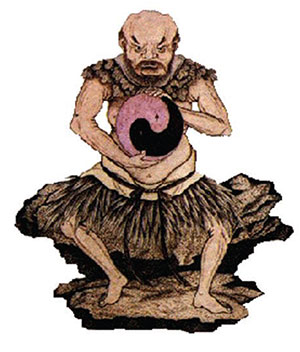 Before the beginning of time, before heaven and earth, there was nothing, and out of this void a great cosmic egg emerged. Floating within the sea of chaos was a divine embryo, as yet unformed, who came to be known as P’an Ku. For 18,000 years P’an Ku, protected by this cosmic egg, floated in a chaotic primal sea, maturing and becoming. When he was ready, his generative cycle completed, from within the egg he uses a hammer and chisel to free himself. As the egg split apart, one became two, all that was high and clear was sent above to form the heavens and all that was dark and turbid was sent below to form the Earth. And there between Heaven and Earth stood P’an Ku hammer and chisel in hand. Legends tell us that his body transformed nine times daily, while the pure dome of his head supported the Heavens and his feet brought stability to the Earth. If you could have looked upon him you would have seen a great and mighty creature covered with hair, with two great horns on his head, and two tusks protruding from his lower jaw. For another 18,000 years, P’an Ku chiseled the Earth and Sky apart. He worked tirelessly, as each day Heaven increased ten feet in height, Earth grew ten feet in thickness, and P’an Ku grew ten feet in length. This was exhausting work for P’an Ku, and it is said that when he wept his tears became the Yellow River. Once the Earth and Heaven were in their proper place, P’an Ku, the first great creator, knew that it was time to complete his work. His expansive growth, length after length, served a divine purpose. At last, he was ready to perfect the Universe. As he lost physical form, (some might call it death), he brought life to the Heavens and the Earth. His flesh formed the soil of the fields, and his limbs marked the four directions, while his body also formed the five sacred mountains of China. To the East the T’ai Mountains were formed from his head; in the West from his feet the Hua Mountain formed. The North and South Heng Mountains were formed from his right and left arm respectively. In the Center, from his trunk emerged the Central SungMountain. It is from his bones and marrow that all the rocks, metals, and precious stones came forth. From his blood the rivers and seas, and from the thick hair that covered his body all the trees, plants, and vegetation of the Earth burst forth, rich and green. His breath became the wind, his voice created the thunder and his beard made all the great constellations of the sky. From his right eye came the moon, and his left eye, the sun. And from his saliva and the sweat of his hard working body came the rain. Lastly, mankind was formed from the vermin that covered his body. So we see how from the one, the sacred egg, the two came forth to form Heaven and Earth. The heaven the earth and P’an Ku represent the three from which all of creation is formed.[14, 16, 17] Just as P’an Ku brings forth the Sun and the Moon of equal stature so too the Earth and Heavens are equal, and P’an Ku resides in the Middle, neither male, nor female representing all of humanity.
Before the beginning of time, before heaven and earth, there was nothing, and out of this void a great cosmic egg emerged. Floating within the sea of chaos was a divine embryo, as yet unformed, who came to be known as P’an Ku. For 18,000 years P’an Ku, protected by this cosmic egg, floated in a chaotic primal sea, maturing and becoming. When he was ready, his generative cycle completed, from within the egg he uses a hammer and chisel to free himself. As the egg split apart, one became two, all that was high and clear was sent above to form the heavens and all that was dark and turbid was sent below to form the Earth. And there between Heaven and Earth stood P’an Ku hammer and chisel in hand. Legends tell us that his body transformed nine times daily, while the pure dome of his head supported the Heavens and his feet brought stability to the Earth. If you could have looked upon him you would have seen a great and mighty creature covered with hair, with two great horns on his head, and two tusks protruding from his lower jaw. For another 18,000 years, P’an Ku chiseled the Earth and Sky apart. He worked tirelessly, as each day Heaven increased ten feet in height, Earth grew ten feet in thickness, and P’an Ku grew ten feet in length. This was exhausting work for P’an Ku, and it is said that when he wept his tears became the Yellow River. Once the Earth and Heaven were in their proper place, P’an Ku, the first great creator, knew that it was time to complete his work. His expansive growth, length after length, served a divine purpose. At last, he was ready to perfect the Universe. As he lost physical form, (some might call it death), he brought life to the Heavens and the Earth. His flesh formed the soil of the fields, and his limbs marked the four directions, while his body also formed the five sacred mountains of China. To the East the T’ai Mountains were formed from his head; in the West from his feet the Hua Mountain formed. The North and South Heng Mountains were formed from his right and left arm respectively. In the Center, from his trunk emerged the Central SungMountain. It is from his bones and marrow that all the rocks, metals, and precious stones came forth. From his blood the rivers and seas, and from the thick hair that covered his body all the trees, plants, and vegetation of the Earth burst forth, rich and green. His breath became the wind, his voice created the thunder and his beard made all the great constellations of the sky. From his right eye came the moon, and his left eye, the sun. And from his saliva and the sweat of his hard working body came the rain. Lastly, mankind was formed from the vermin that covered his body. So we see how from the one, the sacred egg, the two came forth to form Heaven and Earth. The heaven the earth and P’an Ku represent the three from which all of creation is formed.[14, 16, 17] Just as P’an Ku brings forth the Sun and the Moon of equal stature so too the Earth and Heavens are equal, and P’an Ku resides in the Middle, neither male, nor female representing all of humanity.
Earth as Archetype
Earth often represented as the Great Mother is one of the most powerful, consistent archetypes, spanning the globe, and cultures from ancient Sumer, to contemporary times. Whether she is viewed as a vessel, the cosmic egg, a nurturing, loving creator of all life, or the Terrible Mother a destroyer of nature, this primordial image is deeply embedded in the human psyche. This archetype can be found throughout human history, in the artwork, myths and dreams of the earliest people, and today we see it expressed in the psyche, and in conscious and unconscious thought.[4, 13] Neumann states that the positive side of the Great Mother is represented in the round container that is the uroboros, (a snake or dragon shown swallowing it’s own tail and forming a circle) representing life, and psyche, and providing nourishment, protection, and refuge without division. Representations of this form of the Mother Goddess have been found in Egypt, Phoenicia, and Babylon, in excavations at Ur and Erech. The round is symbolic of the great serpent or Python. Before Apollo ruled at Delphi it was the home of Gaia, the prophetic priestesses that served her, and the great earth snake Python, who resided in the omphalos, the navel of the Earth. Serpents represent the spirit of earth and water, are seen as protectors of sacred springs, connected to birth and death, and they play a significant role in Earth Centered myths throughout the globe. It is not a stretch to see P’an Ku, growing ten feet a day in length for 18,000 years as an embodiment of the great serpent. “To the ancients, the cosmic serpent—the spirit of earth and water—was everywhere known as the energy source of life: of healing and oracular powers, fertility and maternal blessings.”[18]
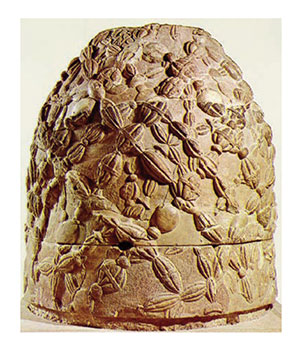 The omphalos, home to the Python, was built in the shape of a beehive. The beehive is culturally significant as the bee is seen as a symbol of the Goddess, and it is the female bees that build the hives and make the honey. A Minoan Seal Ring, from approximately 1500 BC, shows the image of the Bee Goddess. The beehive is also the shape of clay ovens, still used to this day around the world, and seen in our own neighborhood in Northern New Mexico. Jung associated the Mother Archetype with ovens, cooking vessels, and other hollow objects that mirror the shape of a woman’s uterus.[19]
The omphalos, home to the Python, was built in the shape of a beehive. The beehive is culturally significant as the bee is seen as a symbol of the Goddess, and it is the female bees that build the hives and make the honey. A Minoan Seal Ring, from approximately 1500 BC, shows the image of the Bee Goddess. The beehive is also the shape of clay ovens, still used to this day around the world, and seen in our own neighborhood in Northern New Mexico. Jung associated the Mother Archetype with ovens, cooking vessels, and other hollow objects that mirror the shape of a woman’s uterus.[19]
Jung wrote extensively about the Mother Archetype, associating it with all aspects of creation, from the fertility of the earth, as seen in a freshly ploughed field, or an abundant garden, to images and shapes seen throughout nature.
It can be attached to a rock, a cave, a tree, a spring, a deep well, or to various vessels such as the baptismal font, or to vessel-shaped flowers like the rose or the lotus. Because of the protection it implies, the magic circle or mandala can be a form of mother archetype. Hollow objects such as ovens and cooking vessels are associated with the mother archetype, and, of course, the uterus, yoni, and anything of a like shape.[19]
Other universal symbols of the Great Mother are the numerous Mountain ranges of the world. Many mountain ranges were originally named for the Goddess of the Universe, including Chomo-Lung-Ma, which means Goddess Mother of the Universe that is known today as Mt. Everest, and Annapurna, which translates to Great Breast Full of Nourishment. “In every land the mountains were identified with breasts, belly, or mons veneris of the Earth, as well as the home of the gods.”[11] Campbell interpreting Sumerian tablets describes a great mountain rising from the sea, where both are perceived to be living creatures. “...it was the glorious world mountain marked in its stages by the orbits of the circling spheres—the Moon, Mercury, Venus, and the Sun, Mars, Jupiter and Saturn—that the imposing temple towers were designed to produce in local, visible form.”
Our connection to the Great Mother, the natural world, the sacred waters, mountains, and stones, is embodied by the International Council of Thirteen Indigenous Grandmothers. These women stepped forward as a group shortly after the bombing of the World Trade Center in New York, on 9/11, to fulfill a prophecy that their tribes have known for generations. It was said that at the time of the Great Turning they must come together to share their teachings and rituals. They believe that all life is sacred, and that humanity will not survive if we remain disconnected from Earth, the planet that gives us life, sustenance and nurturance of body and soul. If we do not change, then hunger, poverty, war, and illness will prevail.[20]
Just as Jung writes about the Earth Archetype, embedded in nature, and the rock, the Thirteen Indigenous Grandmothers believe the very essence of the creator can be found in a stone. The simple act of picking it up, holding, and communing with it can provide us with profound insights about the Earth, the Cosmos, and ourselves.
 The grandmothers come from the four directions of the world. They represent a global alliance of women from tribes in the Arctic Circle, North, South and Central America, Africa, Tibet, and Nepal. They tell us that we must awaken from our trance and understand, at a soul and spirit level, that the Earth is shaking. We must remember how to honor all life, and how to sustain ourselves. “The grandmothers teach that healing, quality of life, and spiritual evolvement are never separate from politics and consciousness.”[20] This concept is not that different than that of the ancient Chinese who believed that a healthy state must be in resonance with the Cosmos[3] and that Heaven, Earth, and Humanity form an inseparable unity.
The grandmothers come from the four directions of the world. They represent a global alliance of women from tribes in the Arctic Circle, North, South and Central America, Africa, Tibet, and Nepal. They tell us that we must awaken from our trance and understand, at a soul and spirit level, that the Earth is shaking. We must remember how to honor all life, and how to sustain ourselves. “The grandmothers teach that healing, quality of life, and spiritual evolvement are never separate from politics and consciousness.”[20] This concept is not that different than that of the ancient Chinese who believed that a healthy state must be in resonance with the Cosmos[3] and that Heaven, Earth, and Humanity form an inseparable unity.
From indigenous cultures, we also see the relationship of the Mother Goddess to creation through the tales of weaving and spinning which are historically seen as women’s work, but tied to the Great Goddess as the weaver of the web of life, and human fate, and the spinner of the cosmos.[4] To the Navajo people, Great Spider Woman is the original weaver of the universe, and every woven creation made to this day is believed to be a sacred representation of her.[18]
Jung articulates the duel nature of the Mother Archetype as representing both the light and dark aspects of creation, which are also evident in the associated Great Spider Woman myths, whether she is seen as a spinner of the Universe, in control of the Wheel of Fate, or devouring her mate, which leads to her association with the goddess of death.[11]
The qualities associated with it are maternal solicitude and sympathy; the magic authority of the female; the wisdom and spiritual exaltation that transcend reason; any helpful instinct or impulse; all that is benign, all that cherishes and sustains, that fosters growth and fertility. The place of magic transformation and rebirth, together with the underworld and its inhabitants, are presided over by the mother.[19]
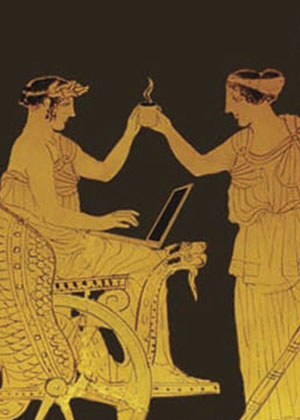 It is through the story of Demeter and her daughter Persephone being spirited away to the underworld by Hades, that we can see how this archetype comes to be associated with things that are perceived as evil- the witch, serpent, or dragon, and with all that is poisonous, dark, hidden, secretive, and associated with the dark underworld. This also relates to the mythic images of the Mother Goddess where she is associated with a darker more bloody, warrior aspect, represented in myths from Egypt, India, Africa, and Asia Minor, and equally tied to witchcraft and sorcery.[13] The more bloody or warrior aspect of the Earth goddess can also be tied to the woman as life giver, as early cultures made the connection between blood and fertility, and the shedding of blood, linked to women’s cycles, where women often removed themselves from their daily activities to gather in community and share sacred space. “...The shedding of blood was a sacred act, whether it was the blood of a wild beast, a domestic animal, or man. The earth must drink blood if she is to be fertile, and therefore libations of blood are offered up to increase her power. But the mistress of the blood zone is woman. She has the blood magic that makes life grow. Hence the same goddess is often mistress of fertility, of war, and of hunting.”[13]
It is through the story of Demeter and her daughter Persephone being spirited away to the underworld by Hades, that we can see how this archetype comes to be associated with things that are perceived as evil- the witch, serpent, or dragon, and with all that is poisonous, dark, hidden, secretive, and associated with the dark underworld. This also relates to the mythic images of the Mother Goddess where she is associated with a darker more bloody, warrior aspect, represented in myths from Egypt, India, Africa, and Asia Minor, and equally tied to witchcraft and sorcery.[13] The more bloody or warrior aspect of the Earth goddess can also be tied to the woman as life giver, as early cultures made the connection between blood and fertility, and the shedding of blood, linked to women’s cycles, where women often removed themselves from their daily activities to gather in community and share sacred space. “...The shedding of blood was a sacred act, whether it was the blood of a wild beast, a domestic animal, or man. The earth must drink blood if she is to be fertile, and therefore libations of blood are offered up to increase her power. But the mistress of the blood zone is woman. She has the blood magic that makes life grow. Hence the same goddess is often mistress of fertility, of war, and of hunting.”[13]
Archeologist and scholar, Maria Gimbutas, dates the great mother back at least 20,000 years to matriarchal, earth centered, old Europe, an egalitarian society which was over run by Indo-European people.[21] In his Essay, The Mystery Number of the Goddess, Campbell, cites Gimbutas, and provides a deep overview of the Mother Goddess culture, from old Europe to Sumer, demonstrating that it is the basis of the first known myths. The critical point that Campbell makes is that the earliest myths are emphatically nature based, and the female body is viewed as the giver of all life in the universe, in whatever form she takes.
...in every lifetime there is indeed a period when the mother, specifically the mother’s female body, is, in fact the universe...it would be possible even to argue that the infant’s initial experience of the mother as universe, transformed in later life to the universe as mother should be recognized as the primal impulses of all mythological symbolization...not only of Old Europe but of the whole range known to us of peoples of the world, the mysterium tremendum et fascinans of life itself as motherhood and as birth, as growth and as transformation terminating in a return to the mother in death, out of which source appears new life, is universally, at this stage of civilization, the all-engrossing, first and last concern.[22]
 Campbell also links Pythagorean thought, and the tetraktys, the upward pointing triangle, to the Indian tantric diagrams of the female yantra. “This triangle is an adaptation of the prominent genital triangle of the typical Neolithic female statuette. The dot is known as the bindu, the ‘drop’ (which like a drop of oil in water, expands), and the triangle as the yoni (womb, vagina, vulva; place of origin, birth and rest).” The Pythagorean idea of the Music of the Spheres, can also be related to the concept of Gaia and Uranus, for contained within the concept of the Music of the Spheres is the belief that sound, the very nature of the universe, resides in all living things. “Within the field of mythic thought...both metaphorically (as one’s nature knows) and historically (as Gimbutas shows) the God beyond God is God’s Mother.”[22]
Campbell also links Pythagorean thought, and the tetraktys, the upward pointing triangle, to the Indian tantric diagrams of the female yantra. “This triangle is an adaptation of the prominent genital triangle of the typical Neolithic female statuette. The dot is known as the bindu, the ‘drop’ (which like a drop of oil in water, expands), and the triangle as the yoni (womb, vagina, vulva; place of origin, birth and rest).” The Pythagorean idea of the Music of the Spheres, can also be related to the concept of Gaia and Uranus, for contained within the concept of the Music of the Spheres is the belief that sound, the very nature of the universe, resides in all living things. “Within the field of mythic thought...both metaphorically (as one’s nature knows) and historically (as Gimbutas shows) the God beyond God is God’s Mother.”[22]
The deep psychological connection between humanity and the Earth has also given rise to an entirely new form of psychology, eco-psychology, which explores the synergistic relationship between personal and planetary wellbeing, recognizing that the needs and rights of our planet are the needs and rights of the individual. This also ties conceptually to James Lovelock’s Gaia Hypothesis, which he proposed nearly 30 years ago, essentially stating that the Earth functions as a single organism and maintains the very conditions it needs for its own survival. Although his findings were initially met with ridicule by the scientific community he has continued to be a champion of this theory, and believes that as a result of the environmental degradation and damage that humanity has done to the Earth that she is fighting back and we are in essence at war with the Earth and have become her target.[23]
We have daily evidence that what is happening to our Earth is also happening to Earth’s inhabitants. The rise in autoimmune diseases, asthma, diabetes, and toxicity is a mirror. According to recent data released by the International Diabetes Foundation, the number of people suffering from diabetes around the globe has skyrocketed in the last two decades, from 30 million to 230 million.[24] Asthma is one of the most chronic diseases in the world, affecting more that 300 million people worldwide. It is estimated that by 2025, this number will increase by more that 30%.[25] Research also demonstrates that the current generations of children in many countries have a shorter life expectancy then their parents' generation, a phenomenon that can only be attributed to the impact of environmental factors on human health.[26] We can no longer ignore the fact that the toxicity of the Earth is responsible for the rise in numerous diseases, or that global warming presents many serious problems.
In his book, Blessed Unrest, Paul Hawken identifies the convergence of the environmental and social justice movements as the largest global social movement in history and acknowledges that no one knows its scope. It appears to be focused on eliminating the division between ecology and human rights and is directing efforts toward healing the wounds of the Earth, “The way we harm the earth affects all people, and how we treat one another is reflected in how we treat the earth.”[27] The Earth Charter is reflective of the Gaia Hypothesis, and the views of the Indigenous Grandmothers, and is also in resonance with the social movement that Hawken identifies. This charter is a declaration of the fundamental principles for building a just, sustainable, and peaceful global society that recognizes that environmental protection, human rights, equitable development, and peace are interdependent and indivisible, and that we must find common ground that recognizes that the protection of Earth’s diversity and beauty is a sacred contract.[28]
This sacred contract with the Earth, our home planet, is at the foundation of the Acutonics Healing System, it is one of the most fundamental principal of Taoist traditions, and many contemporary healing modalities, As Above So Below, As Within So Without, or in the immortal words of Chuang Tzu all things and I form an inseparable unity. The Acutonics system provides a unique synthesis between East Asian Medicine, Psychology, and the Planets that supports the integration of the individual with their greater environment, and recognizes the primacy of the unity between body, mind, and spirit, in optimal health.
The different facets of the Earth are represented in the rich archetypal qualities accessed by the Earth tones in the Acutonics system. The Ohm Unison is our home tone. The Earth Day has a generative birthing capacity, mother of life and all creation. The Zodiac Earth is perhaps best represented in the image of the Mother Goddess who created time and space, as it represents the cycle of the Earth traveling through the zodiac, a 25,920 year cycle, dispersing energy, and gathering wisdom.
The Chinese saw a mirror image of the natural world, including the celestial sphere, captured in a sophisticated network of energy meridians and points. The Five Element System of East Asian Medicine has two recognized configurations; one of them arranges 4 of the 5 East Asian elements – wood, fire, metal and water – in a wheel around the 5th element, earth. This unusual orientation of the elements echoes the fundamental primacy of earth in our psychospiritual makeup.
The ancient Taoists were also aware of the importance of Earth in their spiritual practices, and viewed the Earth, due to its immediate proximity to human beings, as the most influential of all astral energies. They acknowledged what they termed the Earth Force as one of the three principal sources of external qi, one that nourished the physical body, supplying the energy required for daily living and self-healing. [29]
In Acutonics we synergize the use of planetary healing instruments, such as tuning forks and planetary gongs with constitutionally oriented treatment protocols that address the whole body. In essence we integrate cosmic energy with Earth energy in a way that is unprecedented.
Astrologically when the Earth is placed in a chart, (though normally it is not shown in charts) it is located 180 degrees from the Sun, which many astrologers believe is a key missing polarity in a person’s chart. This polarity between the Earth and Sun plays a crucial role in our ability to integrate the disparate parts of our selves and to understand the work we’ve been called to do here in this lifetime. “Just as the Sun in our charts is one form of father (the radiant, creative, spiritual father), Earth as its polarity would address the radiant, inner, spiritual mother.”[30]
If we further explore the interdependent and interrelated creative union between the earth and sky, Gaia and Uranus, or through the myth of P’an Ku it is easy to understand the archetypal quality of the Earth in a person’s chart, “...the collection of veins, arteries, muscles, neuro-indicators, limbs, nerves and cells which make up the human body, and which all work together as a team to create a healthy, vital organism, or in the macrocosm, the oceans, forest, deserts, mountains, rivers, and glaciers which make up our world, as well as the numerous species which inhabit the earth, allowing these parts to all work together to create a healthy, vital planet.” [30]
The Earth — Ohm — Applications and Use
Physiological Actions: Harmonizing, grounding, rooting, and balancing.
The Ohm is the ground, or solid Earth tone, which roots all the healing harmonies in the Acutonics system. The Ohm is considered the fundamental tone that forms the basis of the intervals. Each of the other Earth tones and all the planetary tones used in clinical treatments are combined with the Ohm for its balancing and rooting qualities. It allows us to access the energies of the Solar System while maintaining our center of gravity here on the planet where we reside.
Ohm Unison Interval
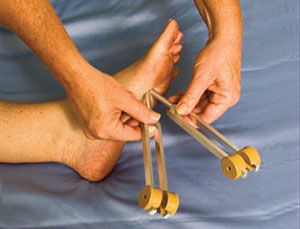 The Ohm Unison Interval consists of two Ohm forks combined so that the same tones are united. The combination of these two Ohm tones reinforces the energy of balancing, centering, rooting, and grounding.
The Ohm Unison Interval consists of two Ohm forks combined so that the same tones are united. The combination of these two Ohm tones reinforces the energy of balancing, centering, rooting, and grounding.
Therapeutic Applications: Use the Ohm Unison in all instances where rooting, grounding, and balancing are needed. Most treatments should begin and end by applying the Ohm Unison to the KID 1, Gushing Spring points on both feet for grounding. The Ohm Unison can also be used on other points whose functions include rooting and balancing, such as the Huato Jiaji points, for grounding and calming the nervous system, the Baliao points, REN 4, Origin Pass, and REN 6, Sea of Qi. This combination can also be used on the source points of meridians to balance the energy in the meridian and its corresponding organ. When you are unclear about which intervals to use, the Ohm Unison will begin the process of harmonizing and may help to clarify the clinical presentation.
Ohm Octave Interval
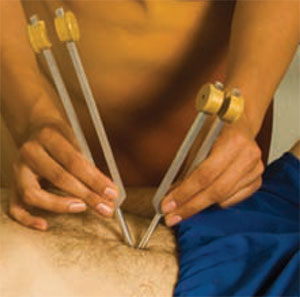 The Ohm Octave Interval combines the middle Ohm tuning fork with the Low Ohm tuning fork. The Low Ohm is eight whole tones lower than the Middle Ohm and one-half its frequency. It is the same tone reflected in a lower octave, providing a sense of linkage. Moving from one octave to the next conveys an energetic of completion. The Ohm Octave Interval is used for grounding, harmonizing, and connecting.
The Ohm Octave Interval combines the middle Ohm tuning fork with the Low Ohm tuning fork. The Low Ohm is eight whole tones lower than the Middle Ohm and one-half its frequency. It is the same tone reflected in a lower octave, providing a sense of linkage. Moving from one octave to the next conveys an energetic of completion. The Ohm Octave Interval is used for grounding, harmonizing, and connecting.
Therapeutic Applications: The Ohm Octave Interval can be used to treat disconnection between the upper and lower body. Place the middle Ohm fork on the upper body, for example on REN 17, Chest Center, and the Low Ohm fork on the lower body, for example on REN 4, Origin Pass.
Zodiac Earth
Physiological Actions: Dispersing, dispelling, and meditative.
Zodiac Earth 3rd Interval
 The Zodiac Earth 3rd Interval is comprised of the combination of the Zodiac Earth and Ohm tuning forks. The unity of these tones produces a musical 3rd. The Zodiac Earth 3rd is effective in treating both physical and mental stress. It can be used to release stagnation and constraint and to relieve pain and relax tightness in the body.
The Zodiac Earth 3rd Interval is comprised of the combination of the Zodiac Earth and Ohm tuning forks. The unity of these tones produces a musical 3rd. The Zodiac Earth 3rd is effective in treating both physical and mental stress. It can be used to release stagnation and constraint and to relieve pain and relax tightness in the body.
Therapeutic Applications: To treat tight or painful muscles, apply the Zodiac Earth 3rd Interval directly to the tight, painful area and/or on acupuncture points proximal and distal to the affected area. For sciatica, place the Zodiac Earth 3rd proximal and distal to the area of sciatic pain. For anger and depression, use the Zodiac Earth 3rd Interval, placing the Zodiac Earth fork on LIV 3, Great Surge, and the Ohm fork on LI 4, Union Valley. For bruising, a manifestation of stagnant blood, apply the Zodiac Earth 3rd Interval around the bruise and in the subtle energy fields above the bruise. For stagnant liver energy, use the Zodiac Earth 3rd Interval on LIV 14, Cycle Gate.
Earth Day
Physiological Actions: Energizing, stimulating, and generative.
Earth Day 5th Interval
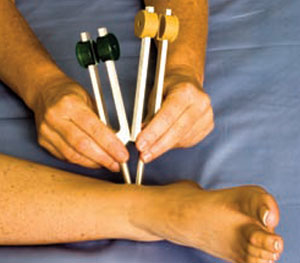 The Earth Day 5th Interval combines the Earth Day fork with the Ohm fork. Their united frequencies create a musical 5th. The Earth Day 5th reflects our daily cycle of waking, living, and sleeping. It is a highly energetic interval. This interval is replicated during the process of photosynthesis by forming the key tension in the nitrogen atom as sunlight is transformed into chlorophyll. The Earth Day 5th builds energy, stimulates, and creates a generative force.
The Earth Day 5th Interval combines the Earth Day fork with the Ohm fork. Their united frequencies create a musical 5th. The Earth Day 5th reflects our daily cycle of waking, living, and sleeping. It is a highly energetic interval. This interval is replicated during the process of photosynthesis by forming the key tension in the nitrogen atom as sunlight is transformed into chlorophyll. The Earth Day 5th builds energy, stimulates, and creates a generative force.
Therapeutic Applications: To treat fatigue, use the Earth Day 5th on points that build energy, such as REN 6, Sea of Qi; REN 4, Origin Pass; KID 3, Great Ravine and ST 36, Leg Three Li.
To fortify or build blood, use the Earth Day 5th Interval on SP 6, Three Yin Intersection, and ST 36, Leg Three Li.
To increase the energy of any organ or meridian, apply the Earth Day 5th to the Source Point of the meridian.
Reference
- Plato and D.J. Zeyl, Timaeus. 2000, Indianapolis: Hackett Pub. Co. xcv, 94.
- Campbell, J. and M.J. Abadie, The Mythic Image. Bollingen series, 100. 1975, Princeton, N.J.: Princeton University Press. {note-a cithara is a musical instrument of ancient Greece which resembles a lyre}
- Sivin, N., State, cosmos, and Body in the Last Three Centuries B.C. Harvard Journal of Asiatic Studies, 1995. 55, Number 1: p. 5-37.
- Neumann, E., The Great Mother; An Analysis of the Archetype. Bollingen series, 47. 1974, Princeton: Princeton University Press.
- Hamilton, E., Mythology. 1st Back Bay pbk. ed. 1998, Boston: Back Bay Books.
- Kerényi, C., The Gods of the Greeks. 2006, New York Thames & Hudson.
- Morford, M.P.O. and R.J. Lenardon, Classical Mythology. Second ed. 1977, New York: Longman.
- Turner, P., C.R. Coulter, and C.R. Coulter, Dictionary of Ancient Deities. 2001, New York: Oxford University Press.
- Guthrie, W.K.C., The Greeks and their Gods. 1st digital print edition ed. 2001, Boston: Beacon Press.
- Bolen, J.S., M.D., Goddesses in Every Woman: Powerful Archetypes inWomen's Lives. 2004, New York: HarperCollins.
- Walker, B.G., The Woman's Encyclopedia of Myths and Secrets. 1st ed. 1983, San Francisco: Harper & Row.
- von Franz, M.-L., Cration Myths. Revised Edition ed. 1995, Boston & London: Shambhala.
- Neumann, E., The Origins and History of Consciousness. Bollingen series, 42. 1993, Princeton, N.J.: Princeton University Press.
- Sproul, B.C., Primal Myths: Creation Myths Around the World. 1st HarperSanFrancisco.
- Laozi and W. Bynner, The Way of Life According to Laotzu: An American Version. 1986, New York, NY: Putnam.
- Yu, D.C., The Creation Myth and Its Symbolism in Classical Taoism. Philosophy East &West, 1981. 31(4): p. 22.
- Werner, E.T.C., Myths & Legends of China. 1976, New York: Arno Press.
- Sjoo, M. and B. Mor, The Great Cosmic Mother: Rediscovering the Religion of the Earth. 2nd ed. 1991, San Francisco, Calif.: Harper San Francisco.
- Jung, C.G., The Archetypes and the Collective Unconscious. 1959, New York: Pantheon Books.
- The International Council of Thirteen Indigenous Grandmothers. [cited 2008 July 1]; Available from: http://www.grandmotherscouncil.com/.
- Gimbutas, M.A.E., The Goddesses and Gods of Old Europe, 6500-3500 BC, Myths and Cult Images. New and updated ed. 1982, Berkeley: University of California.
- Campbell, J. and A.Van Couvering, The Mythic Dimension: Selected Essays 1959-1987. The collected works of Joseph Campbell, v. 11. 2008, Novato, Calif.: NewWorld Library.
- Lovelock, J.E., The Revenge of Gaia: Earth's Climate in Crisis and the Fate of Humanity. 2006, New York: Basic Books. xvii, 176 p. , [8] p. of plates.
- Federation, I.D. Did you Know? Diabetes Facts and Figures. 2007 [cited; Available from: http://www.idf.org/.
- The Increasing Global Impact of Asthma. 2007, European Federation of Allergy and Airways Diseases Patients Association.
- Julia M. Gohlke, C.J.P., The Forest for the Trees: A Systems Approach to Human Health Research. Environmental Health Perspectives, 2007.
- Hawken, P., Blessed Unrest: How the Largest Movement in the World Came into Being, and Why No One Saw it Coming. 2007, New York: Viking.
- The Earth Charter. 1995 [cited 2008 January 15, 2008]; Available from: http://www.EarthCharter.org.
- Chia, M. and Maneewan, Awaken Healing Light of the Tao. 1993,Huntington, NY: Healing Tao Books.
- Guttman, A. and K. Johnson, Mythic Astrology: Archetypal Powers in the Horoscope. 1993, St. Paul: Llewellyn Publications.
